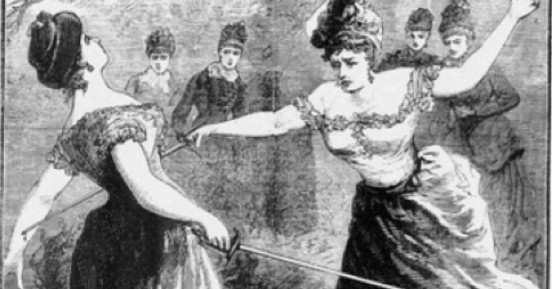One-on-one fights as a point of honor or to settle a score have occurred throughout history. These fights, known as duels, take their name from the Italian duello, which is in turn derived from the duellum; an archaic Latin term for war. People fought duels from the earliest times. The Vikings settled their disputes with holmgang, and in the medieval period, the outcome of accusations and conflicts were decided between two champions in trial by combat. The winner of the duel, whether alive or dead, was deemed to be the moral victor.
Whether they were fought with sword and rapier, as a medieval joust, as pistols at dawn or as a gunfight in the wild west the rules of dueling were the same: both opponents fought with the same weapon. As time progressed, seconds accompanied the combatants, and an adjudicator decided the outcome. Although sometimes, death was the desired outcome, ‘satisfaction’ was usually the primary objective. Most people think duelists were exclusively male. However, throughout history, various ladies have settled their disputes over men, insults to themselves or their families- and even arguments over flower arrangements with dueling.

Christian ‘Kit’ Cavanagh
Christian Davis led a remarkable life. Born the daughter of a Dublin brewer in 1667, as a young woman, she inherited her aunt’s public house. Not long afterward, Christian married one of her servants, Richard Welch. The couple were happy together and had two children. However, in 1691, Welch suddenly disappeared. After frantically searching for him, Christian discovered he had been press-ganged into the British army and sent abroad to fight. So, having secured care for her two children and settled her affairs, Christian disguised herself as a man and joined the army to find him.
Christian, now known as Christopher or ‘Kit’ Welsh took part in several battles in the War of the Spanish Succession. She managed to maintain her disguise as a man despite being captured by the French and wounded several times. She learned to walk and talk like the other soldiers-and to complete her disguise even began to court a Burgher’s daughter, using- as she put it in her autobiography- ” All the ridiculous arts, which I had often laughed at when they were used as snares against myself.”
So successful was Christian’s courtship that the object of her attention fell for her- and Christian herself became fond of the girl, in a platonic way. However, a sergeant from Christian’s regiment also had his eye on the burgher’s daughter. When wooing her failed, this sergeant tried rougher methods. He attempted to take the girl by force and was only prevented from raping her when the girl’s screams summoned the help of her neighbors. Once recovered, the burgher’s daughter went straight to Christian and begged ‘him’ to avenge the insult done to her. Christian, enraged by the attempted rape, went to find the sergeant and challenged him.
The pair bandied insults for a while, with Christian telling the would-be rapist he was “unworthy of the king’s cloth which he wore and ought to be the quarrel of every man in the regiment’ while the sergeant sneered at Christian as “proud, prodigal coxcomb.” However, Christian soon became tired of talking. “I am not come for a tongue battle, Mr. Sargent, “she told him,” but to exact a reparation of honor. If you have as much courage in the face of a man as you have in assaulting defenseless women, go with me immediately to that windmill.”
Christian fully intended to kill the sergeant- and very nearly did so. She inflicted a severe wound to the upper thigh on the sergeant, escaping herself with minor injuries to the arms. The sergeant was bleeding profusely by the time the militia arrived to break up the fight. He was sent to the hospital where he took a great deal of time to recover from his wounds. Christian, however, spent four days in prison. However, the burgher interceded on her behalf. Christian was released with a pardon- but discharged from her regiment. However, her disguise remained intact. So, she merely joined another regiment- and resumed the search for her missing husband.
While Christian Cavanagh fought her duel to defend a lady’s honor, Our next female duelist fought hers because she was the one to offend.

